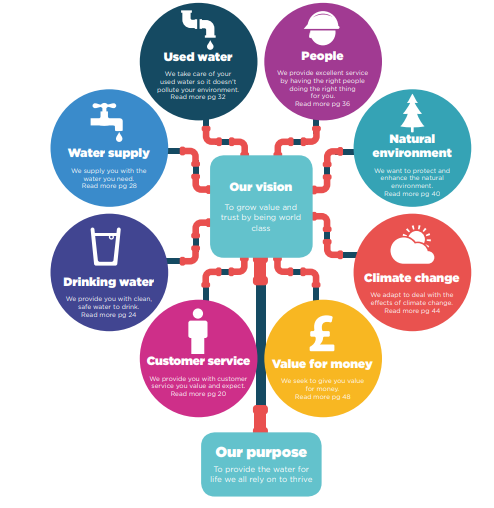In preparation for a recent event, I did quite a bit of research about Northern Ireland Water as I knew it operates differently from the water utilities I am used to. Here is a post about what I found out, how Northern Ireland differes from water companies such as Anglian Water and what I thought about it as a company.
Northern Ireland Water treat 585 million litres of clean
water and 240 million litres of sewage to 1.8 million people through 27,000km
of water pipes and 16,000km of sewage pipes from 23 water treatment works and
1030 sewage treatment works. This water comes from numerous sources, with a composition
of 57.2% rivers and loughs, 42.7% impounding reservoirs and 0.1% boreholes. All this hard work and treatment costs around
£460 million a year. But where does this money come from?
 |
| NIW Annual Report & Accounts 2018/2019 |
Northern Ireland became government owned in 2007 within the
Department of Infrastructure (it used to be local councils). This means that
people in the area do not pay a “water bill” and instead have one charge for a
lot of things, including charges such as council tax. It would be interesting
to know if this had an impact on peoples’ perception on the value of water. It
does not, however, seem to have a great deal of impact on consumption of water,
as there is an approximate use of 150 litres per person per day.
Instead, Northern Ireland Water receive a subsidy payment by
the government. The utility tell the government how much money they required
then that money goes to NIW (including potentially being added up by UK tax
payer money). NIW do not follow AMP years and instead have 6 year Price Control
years, for instance 2015-2021 is in PC15. Despite this, they still follow
regulators such as the DWI but instead of OFWAT they have the Northern Ireland
Authority for Utility Regulation.
 |
| NIW Annual Report & Accounts 2018/2019 |
There are challenges associated with this government business
model though. Unfortunately, the 2015-2031 business plan was underfunded so
around 70 towns had a sewage shortfall. This led to the “drains before cranes”
idea, expressing the importance of ensuring facilities were adequate before a
new development could be built. So this model may have to change in future,
especially because of emerging challenges that are beginning to become
apparent, such as aging population. Northern Ireland Water have projected that
in 2040 25% of the population will be over 65 years old.
 |
| NIW Annual Report & Accounts 2018/2019 |
Despite these challenges, NIW are completing some really
exciting work. One project that I was especially interested in was the “Source
to tap citizen science project”. This is where 30 volunteers in the Erne and
Derg catchments monitored their local biological river water quality.
One thing I noticed that really stood out about NIW was when
I read some documents produced by them, including the 2021-2046 Draft Strategy
and the Drinking Water Quality Annual Report 2018. I was really impressed with the
great infographics and the honesty with which statistics were openly reported
and widely available, including things like PCVs and events. An event of particular
interest to me was in 2018 in Edenaveys Service Reservoir, where 34,941 properties
were overdosed with chlorine because of a component failure. I was amazed that
I could read all about the event, the sample results and more. Genuinely
interesting and open.
So this is what I learned all about Northern Ireland Water and how it differs from water utilities I have encountered before